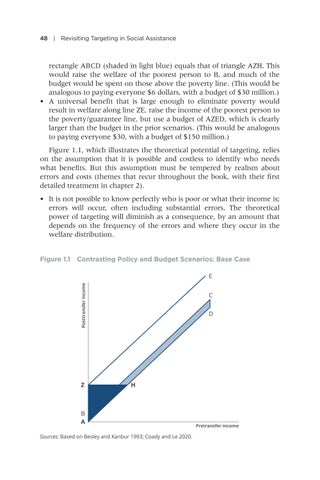48 | Revisiting Targeting in Social Assistance
rectangle ABCD (shaded in light blue) equals that of triangle AZH. This would raise the welfare of the poorest person to B, and much of the budget would be spent on those above the poverty line. (This would be analogous to paying everyone $6 dollars, with a budget of $30 million.) • A universal benefit that is large enough to eliminate poverty would result in welfare along line ZE, raise the income of the poorest person to the poverty/guarantee line, but use a budget of AZED, which is clearly larger than the budget in the prior scenarios. (This would be analogous to paying everyone $30, with a budget of $150 million.) Figure 1.1, which illustrates the theoretical potential of targeting, relies on the assumption that it is possible and costless to identify who needs what benefits. But this assumption must be tempered by realism about errors and costs (themes that recur throughout the book, with their first detailed treatment in chapter 2). • It is not possible to know perfectly who is poor or what their income is; errors will occur, often including substantial errors. The theoretical power of targeting will diminish as a consequence, by an amount that depends on the frequency of the errors and where they occur in the welfare distribution. Figure 1.1 Contrasting Policy and Budget Scenarios: Base Case
Posttransfer income
E
Z
C D
H
B A Sources: Based on Besley and Kanbur 1993; Coady and Le 2020.
Pretransfer income


